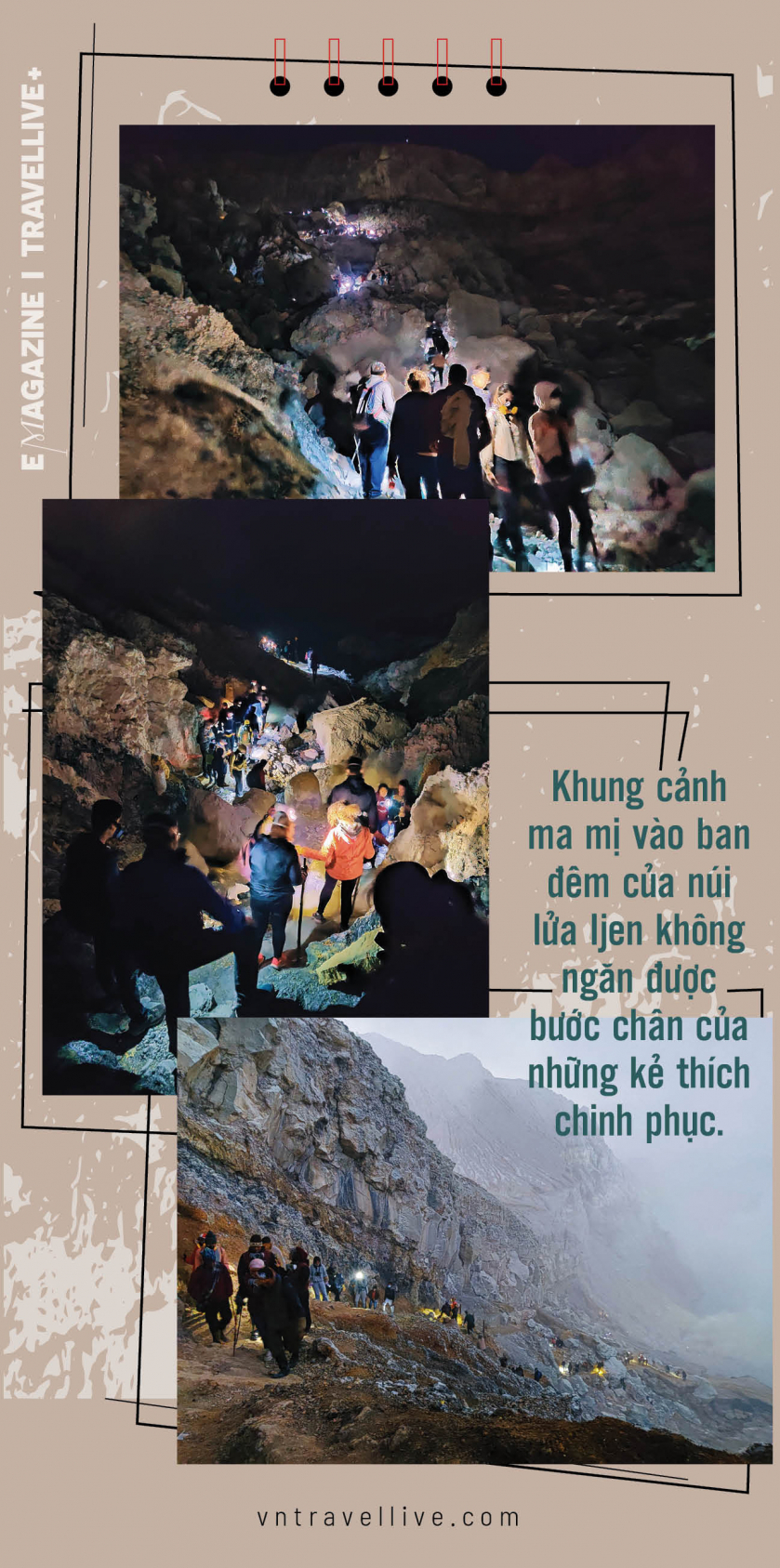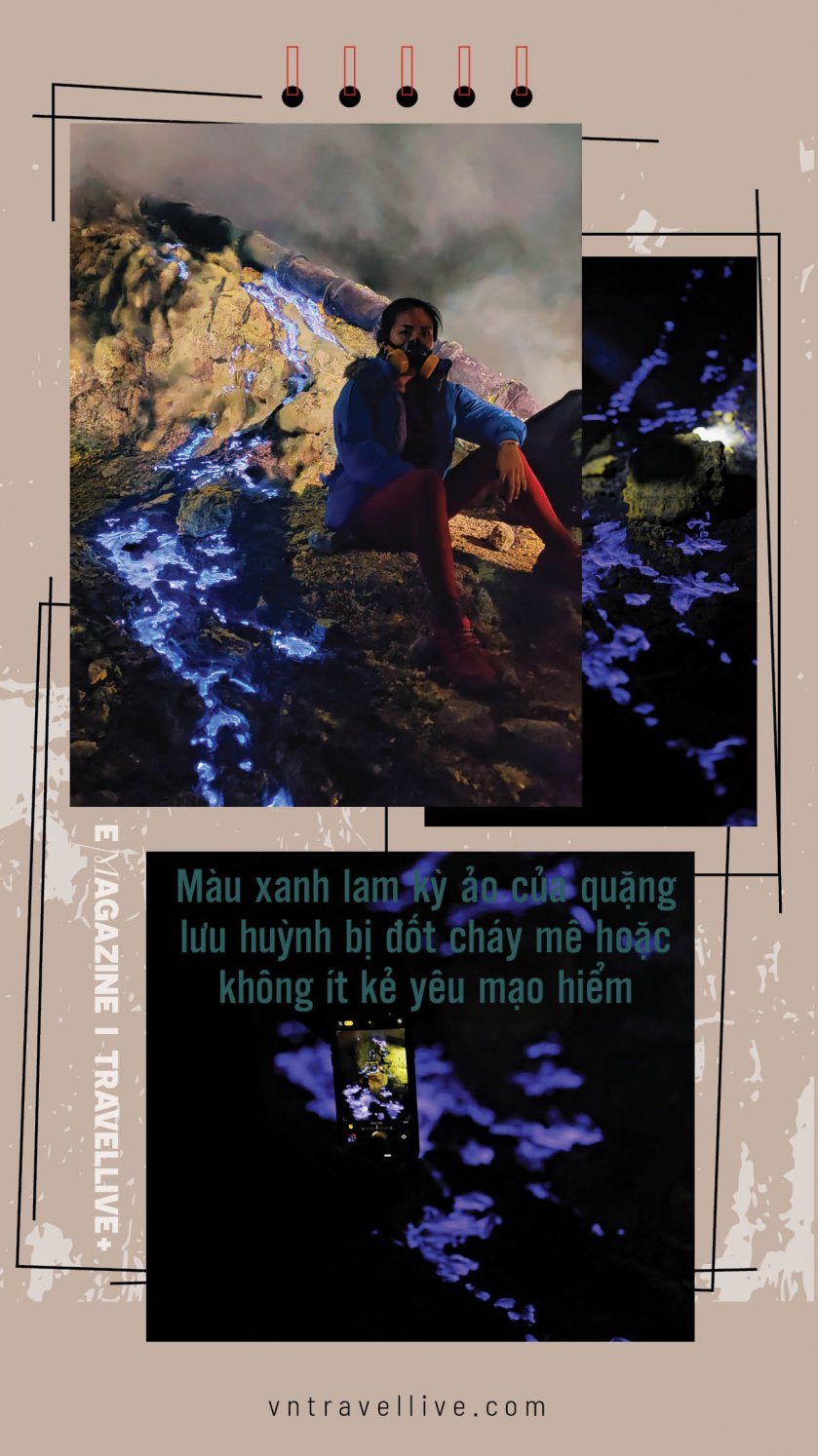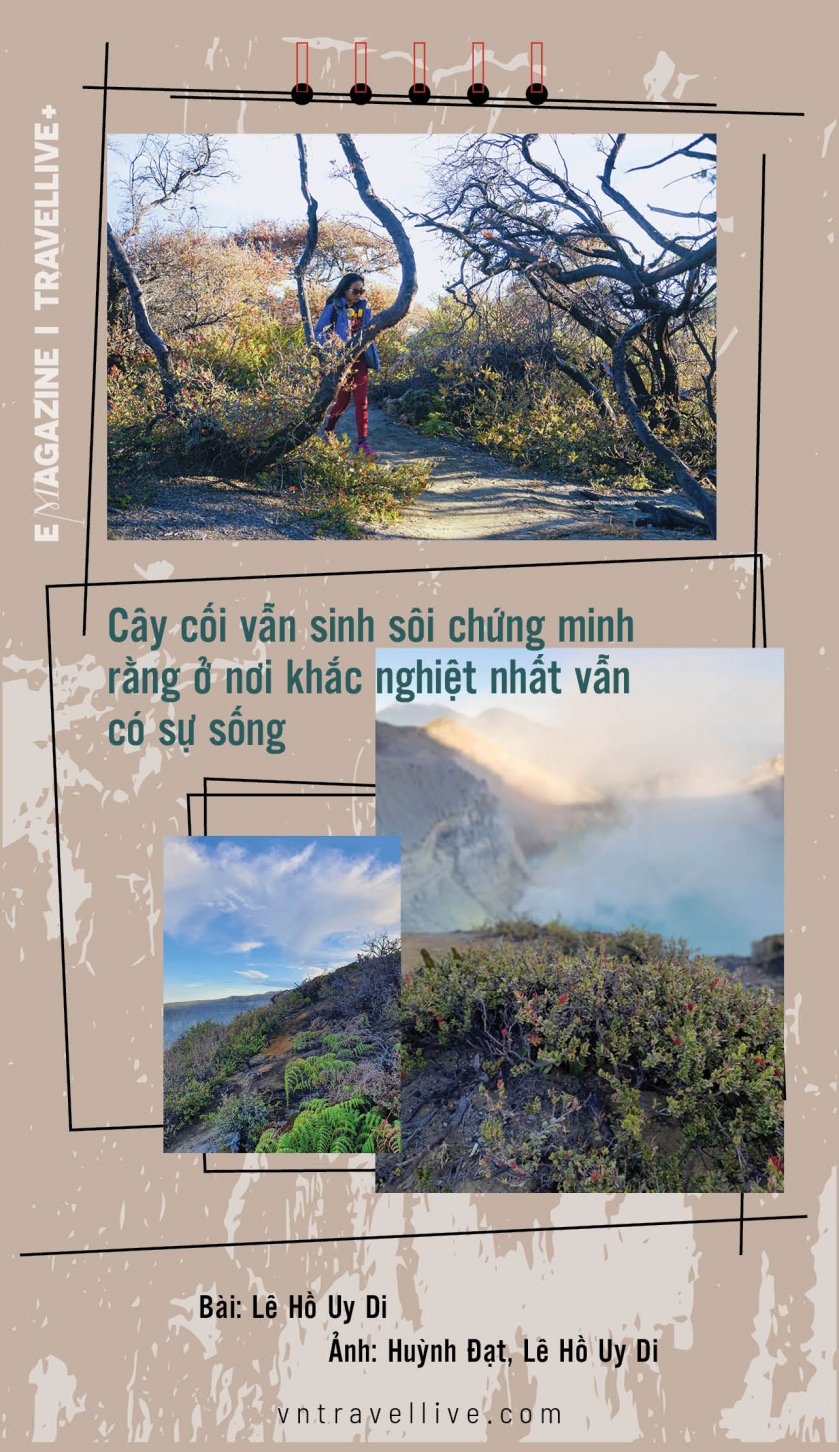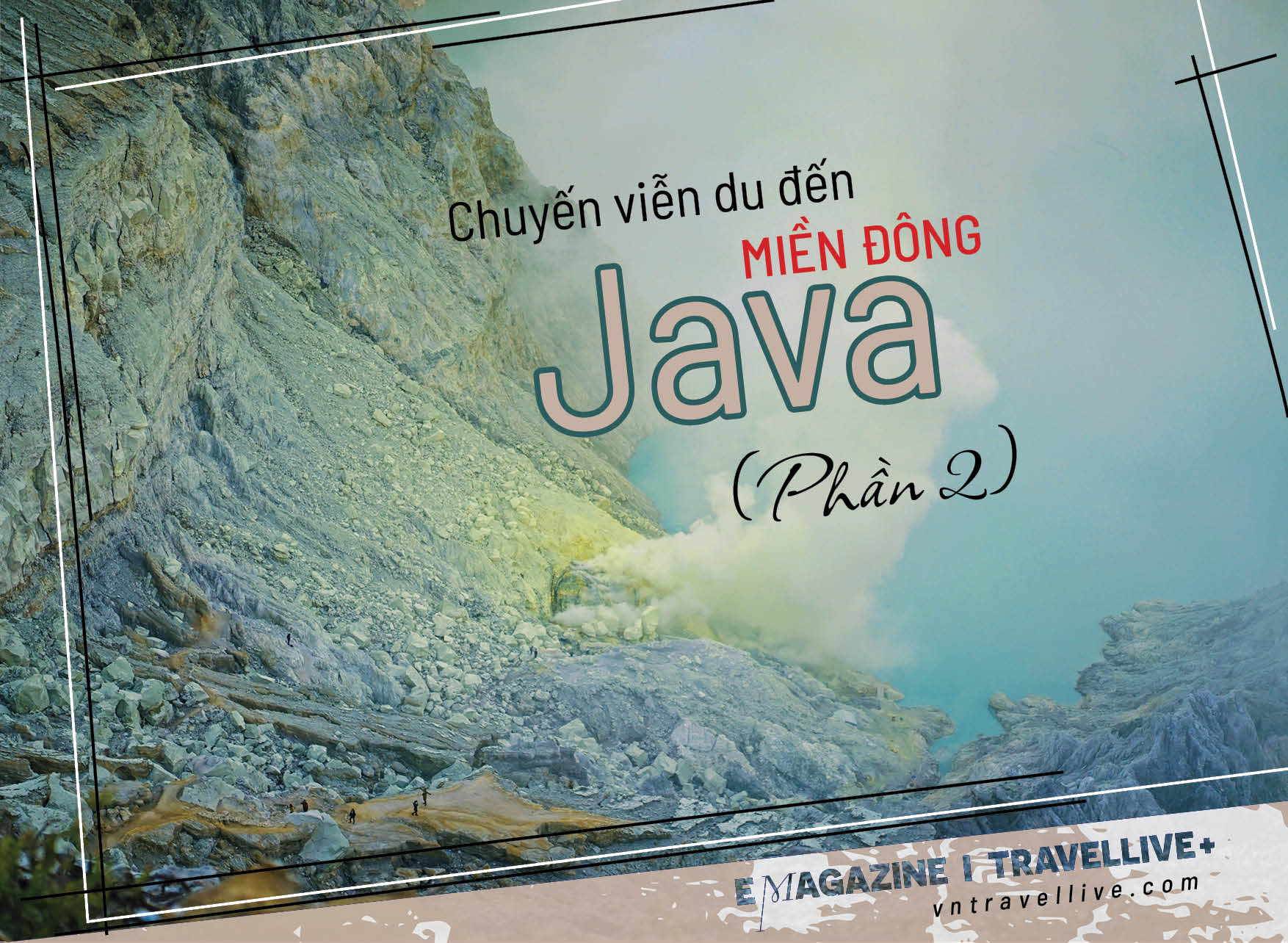The sudden burst of sulfurous smoke stung my nose. Everyone in the group felt a burning sensation in their throats. After that period of “torture”, Ijen treated us to a breathtaking view.


After leaving Bromo Tengger Semeru National Park, I returned to my homestay at 9am. I only had 2 short hours to rest and then continued my journey to Banyuwangi city for the next exploration in 6 hours. During this journey, I slept more in the car than in the hotel.
Banyuwangi is home to Ijen Acid Lake, which is considered the world's largest acid lake and is also a gathering place for many adventurers. Before the trip, I was prepared with basic knowledge and experience when coming to this discovery point. It is known that this place is famous for its blue flames formed from burning sulfur and acid lake with eye-catching emerald green color.
Today’s trip was much harder than the previous one. My group and I had to trek over 3km with slopes from 40 to 60 degrees, in the cold of 10 degrees Celsius. This tour was as crowded as the Bromo volcano. Along the way, if you look back, you will see many lights, illuminating the entire journey.
Lack of sleep, combined with the steep road, caused my group and I to stop many times to rest. The "rickshaw taxis" are always waiting for exhausted customers to offer their services. The people here know how to exploit the economy from tourists. They have amazing health and do not mind hardship. Carrying an average adult weighing 70kg to the top of a mountain of more than 1000 meters seems impossible, but they still do it with each "rickshaw taxi" having 3 people pulling and pushing. Each trip like that costs 800,000 Rupiah.
I wanted to challenge myself so I decided to trek to the top. However, another problem was that the famous blue fire only appeared from 4am and quickly went out before dawn. To get there on time, my group and I had to speed up because not only did we reach the top, but I also had to continue climbing down the mountain for another 40 minutes to reach the burning point of the sulfur.
This was an optional activity on the trip because the burning sulfur gas could obstruct breathing. Without a gas mask, it was easy to suffocate, or even faint. We were carefully instructed to consider whether this activity was suitable for our health conditions. I was one of the people who decided to approach the blue flame.

The journey down, although only 40 minutes, is no less difficult than the journey up, because the terrain is rough, the lava dust covers the rocks, making them slippery, plus the dark sky and the rising sulfur gas clouds that limit visibility. If you are not careful, you can easily slip and fall into the abyss. But it is hard to believe that the more dangerous the place, the more people want to venture into it. Especially when I see the eager faces of each group of people going down, I believe even more that this place must be a paradise for those who love to conquer.
After 40 minutes of struggling, I reached the bottom of the mountain. In the hazy sulfur smoke, I saw a group of people gathered at a cliff. That was where the blue flame was. Everyone knew that sulfur, when burned, would produce a blue flame. On the cracked solid sulfur blocks, the blue flames snaked through the cracks like glowing snakes.
It is known that before the epidemic season, tourists could not stand too close because the fire burned very fiercely. After the tourism opened, the locals here thought of a way, distributing security guards here, taking turns pouring water to cool the fire, from there tourists could get close. To do so, the tourists were told by the tour guide that they should tip those security guards 20,000 Rupiah/guest.
Being so close to the fire, it was inevitable that I would inhale the sulfur dioxide gas. The sudden column of sulfurous smoke filled my nose with an unpleasant smell. Everyone in the group felt their eyes sting and their throats hurt. It was impossible to stay here for long, so after seeing the fire with my own eyes, I quickly left. The sky above was gradually lightening.


As the sky grew brighter, the blue fire began to die out. When it died out, it left a column of smoke that spread everywhere and lasted until sunrise. Those who did not make it out of the mountain in time were swallowed by the smoke and had difficulty breathing.
This is also the time when the sulfur miners begin their work. The Tengger men, with their haggard faces and tanned skin, carry their burdens in the opposite direction from the tourists. They have no protective equipment or gas masks.
On the top of the mountain, some locals are selling sulfur samples that have been carved into flower and animal shapes to tourists for 30,000 Rupiah/product.

To see the sun rise and shine its light on the lake, I had to move to a higher place. It was almost 5am, the acid lake was still hidden by the sulfur smoke. According to the tour guide, no matter how nice the weather is, it is not every day that the acid lake is clearly visible for visitors to see, because the sulfur smoke is always rising, creating a hazy scene.
Luckily for me, because I patiently waited while other friends were too cold and suffocated to go down the mountain early, at around 7am, the sulfur smoke gradually cleared and a beautiful turquoise lake gradually appeared, completely contrasting with the ghostly scene at night.
Above the site where the entire landscape could be observed was a long stretch of low shrubs. Due to the influence of the sulphur-containing air, these shrubs had characteristics to survive in the environment such as small leaves and short trunks. Many of the plants, unable to withstand the harshness, withered away. The taller plants could not develop a canopy. This scene seemed to be taken from a science fiction movie.
In the morning, there will be more groups of visitors, they mainly just want to see the acid lake. These groups of visitors include the elderly and they often use "rickshaws" to get here. Because it was already morning, I discovered that on the mountain mouth there is a "grocery store" selling snacks, instant noodles and even a public toilet. Once again, I admire the way the Tengger people make money.
The sun was high in the sky, shining its harsh rays directly on the sulfur ore, creating a very bright light. I thought it was time to go. The daylight helped me see the steep path more clearly. It turned out that the scenery on the mountainside was so poetic. In contrast to the ecosystem above the mountain mouth, the trees here were green, lush, and shaded the entire path.
When I got on the bus, it was the end of my long journey to East Java. The moments of sightseeing happened very quickly, but to get there, I and other tourists had to spend a lot of time and physical strength. Conquering East Java is really not an easy trip, but the price for what I spent is extremely worth it.















